Spectrum Training Course
Registration is open for the spring 2013 session of the Spectrum Management Boot Camp, a one-day training course to be held May 13th in Arlington, Virginia, USA. This fast-paced course provides a thorough introduction to fundamental spectrum management methodologies, as well as an overview of current technical and policy issues. Topics include: Introduction to radio spectrum, spectrum regulation in the U.S., federal/military aspects of spectrum regulation, satellite coordination, international coordination, and the ITU.
It is organized an taught by the Radio Spectrum Institute, a cooperative venture of 6 experienced spectrum managers with national and international experience in FCC, NTIA, and the private sector.
The course is ideal for those new to spectrum management, and for experienced spectrum managers who wish to delve further into the workings of U.S. and international frequency regulatory bodies.
The Boot Camp syllabus and registration are available here.
The Boot Camp is being held in conjunction with the National Spectrum Management Association annual conference. A combined registration discount is available. For those desiring to attend both the Boot Camp and the NSMA conference, please register through the Radio Spectrum Institute Web site.
FAA's Spectrum Management Activities May Be Getting "Adult Supervision"
If you’re sitting on a plane at the gate and reading this column on an electronic gadget, you’re about to hear eight dreaded words: “Please power down your electronic devices for takeoff.” But this time next year, you might hear something very different: “Please put your devices on ‘airplane mode’ for takeoff.”

In a phone interview, Ms. McCaskill said she had grown frustrated with the F.A.A.’s stance on devices after she learned that the agency now allows iPads as flight manuals in the cockpit and has subsequently given out devices to some flight attendants with information on flight procedures.
“So it’s O.K. to have iPads in the cockpit; it’s O.K. for flight attendants — and they are not in a panic — yet it’s not O.K. for the traveling public,” she said. “A flying copy of ‘War and Peace’ is more dangerous than a Kindle.”

Now maybe if NTIA were more aggressive with FAA in asking it to justify their spectrum management decisions this mess might never have happened. Perhaps if the recommendations of Chapter 5 of the PCAST spectrum report were implemented there would be more accountability by all federal agencies for their spectrum management decisions.
Thanks, Mr. Akin!
On the Assassination of Colorado Corrections Chief Clements
Tom Clements 1955-2013
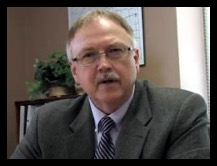
Yesterday Tom Clements, Executive Director of the Colorado Department of Corrections and a 32 year veteran of public service in the corrections area was assassinated at his home by an unknown party. This is sadly reminiscent of the attack on South Carolina Department of Corrections Captain Robert Johnson in March 2010 which is now known to have been ordered over an illicit cellphone operated in a prison.
(Capt. Johnson is now suing 20 cellular industry firms on the issue of whether they were aware of the illicit calls from the prison where he worked but chose instead “to facilitate this illegal activity.” The firms being sued are American Towers, LLC; Farmer Telephone Cooperative Inc.; Cellco Telephone Co. of the Southeast, LLC; Cellco Partnership d/b/a Verizon Wireless; Sprint Cellular Co. of South Carolina; Sprint Communications Co., L.P.; Alltel Communications, LLC; Alltel Communications, Inc.; Alltel Mobile Communications of South Carolina Inc.; T-Mobile USA Tower LLC; T-Mobile USA Inc.; ATT&T Inc.; AT&T Mobility LLC; Verizon Wireless, LLC; Verizon Wireless Service LLC; Verizon Wireless of the East, L.P.; and Tracfone Wireless, Inc.)
I recall a meeting among FCC staffers maybe a decade ago where a colleague, who has since left FCC, wondered why a manager in another part of FCC was so upset about something she said. She commented that “all we do is economic regulations” so it wasn’t “worth getting emotional about”. Well, much of what FCC does is probably “economic regulation” like local zoning and in some way determines who gets more money than another party. But Section 1 of the Communications Act also charges FCC to deal with “promoting safety of life and property through the use of wire and radio communications” and some FCC actions have life and death consequences.
It is too soon to tell for sure if the Clements assassination was connected with illicit cell phone use, but if I was Mitt Romney I would bet $10,000 that it was.
FCC now has in its “inbox” at least 3 petitions dealing with the cellphone in prisons issue that it has not acted on:
- CTIA’s November 2007 petition (Part of this petition not related to prisons was finally addressed in Docket 10-4, but the prison related issues have never been even put out for public comment)
- South Carolina Department of Corrections August 2009 petition (Signed by 30 other state and local corrections agencies)
- GTL July 2011 petition - This petition has disappeared into FCC’s petition “black hole” and is not available on the FCC’s voluminous website which promises “transparency”. However, GTL has provided us with a copy so we can make it available here. (MSS contributed to the drafting of this petition as well as the South Carolina petition. However, no present MSS clients are involved in this issue.)
Chairman Genachowski, these petitions come from a variety of parties - including a major trade association, state governments and a small company - and advocate a variety of actions - some of which are mutually inconsistent.
Isn’t it time to act on this urgent public safety issue and clarify FCC policy by dealing with these petitions one way or another?
UPDATE
No proof yet that this event was cellphone related, but it apparently also occurred to ABC News which posted a story entitled “Prison Chief's Death Highlights Safety Concerns” Here is a section:
Correctional professionals interviewed in the aftermath of the Colorado shooting say the growing influence of prison gangs, their ability to communicate with affiliates on the outside through smuggled cellphones and the ease with which people can be found and tracked online have made the job even more dangerous for them and their families.”
CTIA, why don’t we agree to both ask FCC to act one way or other on these pending petitions, including one of yours, that are gathering dust as people die.
UPDATE 2
Here is the new story about the murder of 2 prosecutors in 2 months in a rural county of Texas. District Attorney Mike McLelland and his wife, Cynthia were found murdered at their home on March 30. Assistant District Attorney Mark Hasse was killed on his way to work in January. Note that the McLelland case MO was they same as in the Clements case and the Johnson case. That does not prove that illicit cellphone use was a factor, but if I was Mitt Romney …
FOIA @ FCC: Is CIA More Liberal?
Redacted version of FCC document received from a FOIA request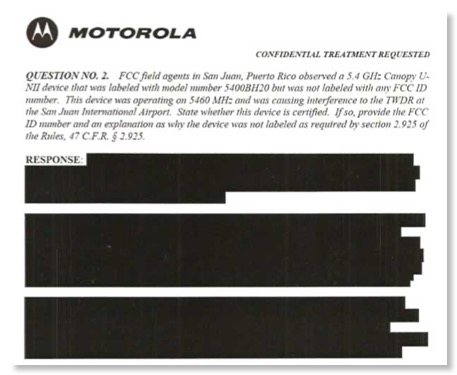
Based on your blogger’s recent encounter with FCC on FOIA issues, it is interesting to see how FCC practice compares with other agencies.
If you want a datapoint on the issue of whether FCC over-redacts documents under FOIA, compare the redactions of the Motorola document to this document, originally Top Secret, but released recently by CIA with redactions.
You can see that FCC is more aggressive with redactions than CIA is!
The FOIA legislation has the following provision (5 U.S.C. 552(b))
Any reasonably segregable portion of a record shall be provided to any person requesting such record after deletion of the portions which are exempt under this subsection. The amount of information deleted, and the exemption under which the deletion is made, shall be indicated on the released portion of the record, unless including that indication would harm an interest protected by the exemption in this subsection under which the deletion is made. If technically feasible, the amount of the information deleted, and the exemption under which the deletion is made, shall be indicated at the place in the record where such deletion is made.
As is clear from the FCC redaction shown above, and even the lesser redactions I received after an appeal to the Commission for review that took almost a year, the Commission has an “unusual” reading of this law. It is hard to imagine why anyone thought the whole text of the above Motorola response was FOIA exempt, especially when you see what it actually said.
Note that the law requires “Any reasonably segregable portion of a record shall be provided to any person requesting such record after deletion of the portions which are exempt under this subsection”. It also requires “If technically feasible, the amount of the information deleted, and the exemption under which the deletion is made, shall be indicated at the place in the record where such deletion is made.” (Emphasis added) Clearly the second requirement was never met and it is dubious that the first requirement was met in this case. However, a review of the formerly Top Secret CIA document shows that the CIA is much closer to compliance than FCC. Why?
We note also that the CIA has a Freedom of Information Act Electronic Reading Room where it posts documents that have been released. FCC has no such information on its voluminous website.
We note also that the Nuclear Regulatory Commission posts on its website both Recent FOIA Requests as well as closed FOIA requests that include the documents released.
FCC appears to have on its web site “Records disclosed in response to a FOIA request that ‘the agency determines have become or are likely to become the subject of subsequent requests for substantially the same records’”, HOWEVER this section is mainly links to other FCC databases and the only real information released under FOIA consists of 3 documents dealing with the investigation of Google’s collection of Wi-Fi data. No other FOIA-released data is available on the website as it is at CIA and NRC. Why?
So FCC appears to have at best a minimal policy of compliance with the FOIA legislation. In view of FCC’s claim of being very transparent, it is puzzling why this is true. This appears to be a longstanding issue at FCC that predates the current leadership, although the current leadership is not making it any better.
UPDATE
FBI may also be more liberal. FBIA documents released under FOIA are available in The Vault. See for yourself how FBI appears to redact with a lighter hand than FCC. Where do FCC documents released under FOIA go? Perhaps to the same black hole as pending petitions at FCC?
FBI’s FOIA site even has video. For example:
Christopher Metsos' brush pass with official from Russian Mission in New York, 5/16/ 2004.
TAC on Spectrum Frontiers: Where Does Innovation Come From?
Visual from 3/11/13 FCC TAC meeting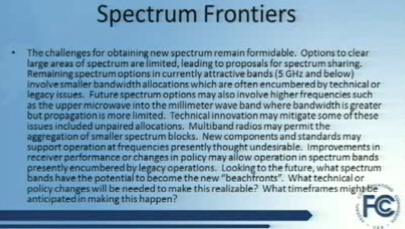
On Mach 11, 2013 the FCC’s Technology Advisory Council held its first meeting of the year. In stark contrast to previous FCC chairmen, Chairman Genachowski opened the meeting and seemed to enjoy being with this group. (I recall when the Disney CTO resigned from TAC a decade or so ago because of his perception that there was no interest in its advice from the 8th Floor and his observation that in a parallel group at SEC that agency’s chairman regularly met with the advisory committee.)
Part of the deliberations dealt with “Spectrum Frontiers” and the slide projected for that discussion is shown at the top of this post. It correctly says that future systems may move into the millimeter wave (mmW) band (frequencies above 60 GHz) and that technical innovations may make use of such higher frequencies more practical.
If you were to ask a prominent communications attorney to do due diligence on a business plan involving technology above 95 GHz I suspect he would report back to potential investors that there would be a 3-4 year delay for new service rules based on recent FCC performance in Title III regulation - think UWB, BPL, AWS-3, TVWhitespace, LightSquared, etc. Would anyone in their right mind invest in technology subject to such regulatory uncertainty?
FCC Chairman Charles Ferris (1977-81)
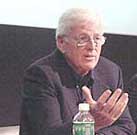
In order to get the investment needed for practical technology in these bands, FCC must give assurance to developers and investors that any deliberations will be both transparent and timely. Comm. Pai has rediscovered the long lost Section 7 of the Communications Act. (It wasn’t really lost, just ignored by FCC for almost 30 years on a bipartisan basis.) Rather than have the TAC deliberate on how this now idle spectrum might be used - perhaps with Soviet-style planning, let’s have faith in the marketplace and encourage capital formation for technology development >95 GHz by giving assurances of timely consideration of any new service rules.
Why doesn’t FCC just declare that technology >95 GHz is presumed to be “new technologies and services to the public” and thus subject to the terms of Section 7. As I read Section 7(a) it would apply to both FCC and NTIA - important since all bands >95 GHz are shared and thus subject to NTIA coordination. (Section 7(b) clearly only applies to FCC.)
Dueling Spectrum Charts - Part 2
Fred Campbell, who during the Chmn. Martin era was the chairman’s wireless advisor and then Chief of WTB, has written a blog post on the new FCC spectrum chart report. Fred questions the consistency of the new data with earlier FCC statements in the merger context:
“It appears that the FCC considers the entire 194 MHz of licensed spectrum in the 2.5 GHz band as available for mobile broadband in the US when the ratio of licensed to unlicensed spectrum and international pride are at stake, but only 55 MHz is available when the FCC considers the impact of licensed spectrum aggregation on mobile competition. If the 139 MHz of spectrum the FCC excludes from its calculations when considering mergers is excluded from the international comparison in Table 1 of the report, the total licensed spectrum in the US that is available for mobile broadband drops from 608 to 469 MHz.”
Fred ends his post with
An exercise for readers is to decide whether the Martin chairmanship was any better on being “focused . . . on facts and data”.An agency that is truly “focused . . . on facts and data” would not pretend otherwise by manipulating facts and data to satisfy its desired results. Sadly, over the last three years, the FCC has demonstrated it is no such agency.
Your blogger was in Japan last week for some speaking engagements. In a talk at ARIB he pointed out the inconsistency of the FCC’s number for Japanese mobile spectrum (500 MHz) and CTIA’s number (347 MHz) and asked which was correct. Fortunately ARIB had just finished a report, in Japanese only, on wireless spectrum use in Japan. The key chart from that report is shown below and indicates 501.2 MHz of commercial mobile spectrum at the moment. So on this point, score 1 for FCC.
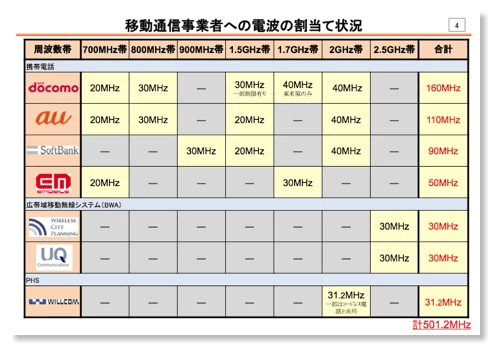
On Fred Campbell’s point, I don’t follow merger issues too closely so I would welcome input from others on who is correct.
(I would be glad to share the ARIB report with others who are interested and can digest the Japanese in it.)
UPDATE
Pierre de Vries, in his Deep Freeze 9 blog, has expanded on this post with respect to alternative ways to quantify spectrum use.
On Unlocking Phones: What is the Real Problem?
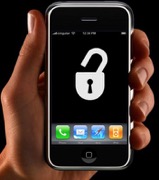
Clearly the situation in the US is more complicated. AT&T argues in its Policy Blog “Bottom line: We unlock our customers’ devices”. But if you look at the comments on AT&T’s blog, 14 at this writing, clearly the customers disagree on the practicality of unblocking AT&T phones in the real world.
One poster wrote:
That’s the first time I’ve ever heard of this policy. You guys refused to unlock my Captivate for 13 months, and you refused it for my Galaxy S III even now, saying I must wait 18 months.
When I bought my iPhone 5 at full retail, it took me three weeks to get you guys to do it, because you required faxing at specific moments, and all sorts of weird stuff. You guys refused to unlock my iPhone 4 until after my contract term expired, and even then, it took four tries to get someone who actually didn’t tell me that you can’t unlock it..
I don’t know what’s going on there, but its obvious you aren’t following that policy you describe.
Another wrote:
Spin, Spin, Spin, you won’t unlock used iPhones purchased on Amazon, eBay or Craigs list. You demand that the requester provide proof of purchase from an “authorized” re-seller and that would only be one of your or Apples retailers. You have and Apple have the IMEI’s so you know if they are out of the contract period it should not matter if someone sold it on eBay or Amazon. As long as it is not stolen and no longer in the contract period, UNLOCK IT.
T-Mobile seems to have a clear, but not necessarily reasonable, policy for unlocking phones. By comparison, VZW’s policy was impossible to find on their website. While the CTIA site has viewpoints on many telecom policy issues, they are mute on this one.
But let’s get to the root of this problem: Most discussions I have seen so far deal with overseas use of US cell phones and the desire of users to buy overseas SIM cards when they travel. (Users might also want to unlock phones to switch carriers, but that appears to be a minority of the users who show up in blogs on the topic.)
As I have written before, I have a minimal cost unlocked GSM phone that I use for foreign travel because US overseas roaming rates are just too high. Indeed, US cellphone rates and wireline rates for much international use are so high they may actually be illegal - a topic the cellphone industry and FCC do not seem interested in.
Thus the current cell phone unlocking discussion, which has reached to the White House, may be basically another manifestation of excessive calling rates for international calls. At least the White House responds to petitions, something that FCC has a poor record of dealing with even when petitions come from major industry groups.
Nationwide Unlicensed TV Whitespace Use at Last!
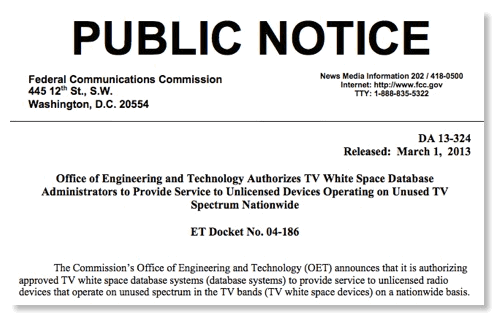
In the above public notice FCC announced the availability of TV white space operation in all US territory. Even though the TV whitespace proceeding has been underway for almost a decade, actual use depended on database administrators being approved and then specific areas being approved. As the PN states,
Previously, OET had authorized database systems to only provide service to TV white space devices in the East Coast region, specifically in the states of New York, New Jersey, Pennsylvania, Delaware, Maryland, Virginia, and North Carolina and in the District of Columbia (Washington, DC).
We now have nationwide availability for the first time.
In a related matter, on February 27 FCC announced a 45-day public trial of Google Inc.’s TV band database system. Spectrum Bridge, Inc. and Telcordia Technologies, Inc. were previously approved as database administrators.
GigaOM: Is Cisco stacking the deck with its mobile data numbers?
To hear Cisco tell it, the world is quickly running out of wireless spectrum. Tim Farrar, of TMF associates, says a look at the numbers shows that Cisco first overstated them, then revised them, and is now overstating them again.
The Cisco mobile VNI forecast (the shorthand for Visual Networking Index: Global Mobile Data Forecast) is widely used as a justification for specific amounts of new mobile spectrum.
For example on p. 76 of the National Broadband Report it says,
According to Cisco, North American wireless networks carried approximately 17 petabytes per month in 2009,7 an amount of data equivalent to 1,700 Libraries of Congress. By 2014, Cisco projects wireless networks in North America will carry some 740 petabytes per month, a greater than 40-fold increase.
A search on “Cisco” in this report gives 50 uses, although some are duplicates involving their URL.
In a recent FCC filing a few days before the GogaOM post CTIA said
These findings by CTIA bear out the numerous expert projections regarding mobile data traffic:
-Cisco’s Visual Networking Index (“VNI”) projects wireless data traffic in 2016 will be 16 times the volume of traffic in 2011, and 100 times the volume of traffic in 2009.9 This projection involves traffic on licensed spectrum alone, taking into account the off-load of other wireless traffic onto unlicensed spectrum. Thus, Cisco’s VNI projections demonstrate the pressure solely on licensed spectrum.
The GigaOM post points out discrepancies between Cisco’s projections and CTIA’s own reporting of actual traffic:
Nevertheless, at least in the U.S. we can attempt to validate Cisco’s numbers, given that CTIA’s mobile data traffic statistics are based on direct reporting by carriers accounting for 97 percent of wireless connections in the U.S.. In its latest forecast, Cisco estimates that mobile data traffic in the U.S. was 128PB/month in December 2011, and increased to 207PB/month by December 2012.
However, CTIA data indicates that 633PB were carried in the first six months of 2012, for an average of 105.5PB each month. Cisco’s estimate for the U.S. is clearly inconsistent with the CTIA statistics: It is hardly likely that monthly traffic declined significantly between December 2011 and June 2012, and equally implausible that total mobile data traffic in the U.S. then doubled in the second half of the year.
Now spectrum needs are different than traffic projections. Spectrum needs depend critically on infrastructure buildout and technology used. There is not a fixed conversion factor from petabytes to MHz.
A key issue for the cellular industry is which is more cost-effective: acquiring additional spectrum or building out infrastructure to the maximum possible. Of course, acquiring spectrum is a good way to assure long term market hegemony for a given carrier, something mere infrastructure buildout does not assure.




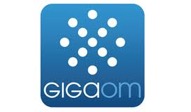



![Validate my RSS feed [Valid RSS]](valid-rss-rogers.png)

